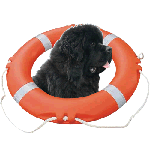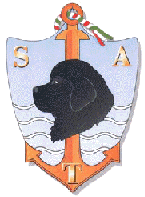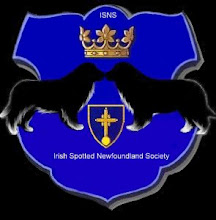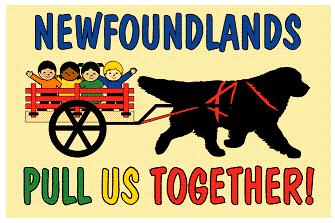Thursday, February 29, 2024
Bobby Kennedy's Newfoundland Dog - Brumus
(Reprinted from "Robert F. Kennedy - His Life and His Legacy" - Time (2018)
"Robert Kennedy was an animal lover, with a collection of pets, primarily dogs. Of this menagerie, his well-known favorite was a Newfoundland Dog named Brumus from Little Bear kennels, who was his devoted companion, often accompanying him to his office while he served as Attorney General in his brother's administration. Seen here in a pose familiar to many Newfoundland owners, Brumus curls up next to his master's chair, keeping him company during his long hours at work.
'The most notorious (of Kennedy’s pets) was Brumus, the malodorous Newfoundland, who peed once on Senator Harry Byrd’s spaniel and twice on two ladies picnicking at Hickory Hill, and who got his name and mug shot on the lyric sheet of the Jefferson Airplane’s Crown of Creation album.
The doors to RFK's office was often open, and the staff felt free to drop in. The walls of his office were covered with his children's drawings, and his oversized, undersupervised Newfoundland dog, Brumus, annoyed visitors. When Bobby brought to work his beloved Brumus, the black Newfoundland who was the size of a pony and could drool at will, he let nature call in the courtyard and trusted the guards would clean up after him. Taped on the walnut paneling were brightly colored drawings done by Bobby and Ethel's children. There was a dartboard on the wall, a football on the desk. And, more often than not, there was Brumus - a huge, ill-tempered Newfoundland who nipped at visitors, stole food, raised his leg on the furniture, drooled on staff. Bobby adored him. If the dog was left at Hickory Hill, he whined at the front door until his master returned. Bobby couldn't bear the idea of Brumus spending a long, unhappy day at home, so every morning, the attorney general and his shaggy sidekick climbed into a chauffer-driven Cadilac and set off for work. Bobby found the limosine a little embarrassing, but the ride gave him a few uninterrupted minutes to go through paperwork - - and besides, Bumus liked it.'"
Friday, February 23, 2024
"Seaman" Statue Repaired After Vandals Strike
(By Doug Flanagan - February 22, 2024 - Cames-Washoul Post Record)
"One of Washougal’s most visible public art installations has been restored after receiving an unwelcome new coat of paint last month. Heather Soderberg Greene, a Cascade Locks, Oregon-based artist, traveled to Washougal on Valentine’s Day, Feb. 14, to show some love for her creation, “Seaman,” the bronze sculpture of a Newfoundland dog that has stood in downtown Washougal’s Reflection Plaza since 2015. Molly Coston, the president of the Washougal Arts and Culture Alliance president and a member of the Washougal City Council, told other city officials on Feb. 12, that the sculpture had been vandalized. 'It was painted with oil-based paints — the whole face red, white and blue. It was very, very obvious. It’s really very ugly. It’s unfortunate,' Coston said. 'This, of course, reminds us that we do need to maintain all of our public artwork, which is an expense for the City.' The Washougal Police Department ("WPD") said they have no leads or suspects, but that the vandalism occurred over the New Year’s holiday. “On. Jan. 3, I was made aware of a cold (case of) malicious mischief at Reflection Plaza. I was told the dog statue ‘Seaman’ had been painted,” Washougal police officer Kyle Kinnan stated in a police report.
'Upon my arrival, I found (the sculpture’s) face painted red, white and blue (and) took photographs of the damage. Looking around, I did not see any businesses with security cameras. I contacted the employees at Mary Jane’s (House of Glass), as they were closest to the damaged statue. They confirmed they did not have cameras that would pick up the location of the statue,' Kinnan stated in the report. “They did tell me the statue was already painted on Jan. 1, when they arrived at work in the morning and believed it was a New Year’s Eve prank.” Green used metalworking tools to remove the sculpture’s patina — a colored film on the surface of the bronze that is produced by oxidation over time — and apply a new one.
'Because of the age and weathering of the statue, I couldn’t just fix his face where the vandalism was done,' she said. 'First, I took a large propane torch and superheated the metal, burning off all debris, wax and clear-coat. The largest problem was the paint used for vandalizing was industrial heat-resistant paint. That was a major problem and took a lot of work removing. I had to use a pneumatic buffer to take it off.'
Once she’d cleaned the sculpture, Green applied a fresh patina. 'I airbrushed a black patina oxide that chemically permeates the hot bronze, turning it black,' she said. 'Once the metal was cool to the touch, I sealed the whole statue with a clear lacquer. When that was completely dry, I waxed the statue to protect the patina and clear-coat from the elements.'
Greene said she was 'very sad and disheartened to hear' that her sculpture had been vandalized. 'I have been very fortunate, and this was the first time it has happened to my statues,' she said. 'I am mostly very sad for the person that damaged him. I am sure they would be very hurt if someone destroyed something that they created. I truly hope that maybe instead of vandalizing other people’s work and property that maybe they would take that energy and put it towards creation and finding an outlet in their own painting — they seem to like colors. Creating art soothes all of my anxiety, pain and uncertainty in the world right now, and I wish for everyone struggling to be able to find a source of comfort.
Greene created the sculpture, which depicts Seaman, the only animal to complete the famous Lewis and Clark Expedition of the early 1800s, in 2015. WACA purchased and installed the structure later that year."
Monday, February 19, 2024
Saturday, February 17, 2024
Thursday, February 8, 2024
Newfoundland Dog Breed: The Gentle Giant with a Heart of Gold
(Political Insights - February 7, 2024)
"Regal, majestic, and downright incredible – these are just a few of the words that could be used to describe the Newfoundland dog breed.
These gentle giants have captured the hearts of dog lovers for centuries, and for good reason.
With their beautiful coats, impressive size, and remarkable temperament, it’s hard not to fall in love with these magnificent canines.
In this exhaustive article, we’ll delve deep into the world of the Newfoundland dog breed and uncover everything there is to know about these big-hearted beauties.
A Glimpse into the Origins of the Newfoundland Dog
As with any breed, the history of the Newfoundland dog is a fascinating tale that offers insight into how these gentle giants came to be. To truly appreciate the uniqueness of this breed, it’s essential to understand its origins, development, and the factors that shaped its physical and behavioral traits.
The Birthplace of a Breed: Newfoundland Island
As the name suggests, the Newfoundland dog breed hails from Newfoundland Island, a remote and rugged region located off the eastern coast of Canada. The island’s challenging climate and harsh terrain played a significant role in shaping the dogs that call it home. The Newfoundland’s ancestors were likely working dogs brought to the island by early European settlers, who required strong, hardy animals to assist them in their daily lives.
From Fishermen’s Helpers to World Renown
Initially, the Newfoundland dog was bred primarily for its working abilities, particularly in assisting fishermen with their heavy nets and gear. The breed’s strength, endurance, and water-loving nature made them ideal for this role, and it wasn’t long before their reputation spread far and wide. By the 18th and 19th centuries, Newfoundland dogs had become highly sought-after across Europe and America, not just for their working abilities, but also for their remarkable beauty and gentle disposition.
A Royal Connection: The Newfoundland’s Noble Fanbase
The Newfoundland dog’s rise in popularity caught the attention of many notable figures, including several members of European royalty. Queen Victoria herself was a known admirer of the breed, owning several Newfoundlands throughout her life. This royal connection helped to further cement the breed’s status as both a working dog and a highly desirable companion animal.
Physical Traits and Characteristics of the Newfoundland Dog
One cannot discuss the Newfoundland dog breed without acknowledging their most striking feature – their size. However, there’s more to these gentle giants than just their impressive stature. Let’s take a closer look at the unique physical traits and characteristics that set the Newfoundland breed apart from other dogs.
Size and Weight: Male Newfoundland dogs typically stand between 27 to 29 inches tall and weigh between 130 to 150 pounds. Females, on the other hand, are slightly smaller, measuring between 25 to 27 inches in height and weighing between 100 to 120 pounds. This makes the Newfoundland one of the largest dog breeds in existence.
Coat and Coloring: The Newfoundland’s coat is thick, waterproof, and double-layered, consisting of a dense undercoat and a long, wavy outer coat. This unique coat allows the breed to withstand the harsh conditions of its native homeland and provides exceptional insulation against cold temperatures. Newfoundland dogs come in a variety of colors, including black, brown, gray, and a distinctive black and white pattern known as “Landseer.”
Muzzle and Jowls: Another distinguishing feature of the Newfoundland breed is its broad, square muzzle and pronounced jowls. These facial traits contribute to the breed’s powerful appearance and also serve a practical purpose – the large jowls help to funnel water away from the dog’s nostrils when swimming.
Webbed Feet: To help them navigate the rough waters of their native environment, Newfoundland dogs have webbed feet, which enable them to swim more efficiently and with greater power. This trait is not only useful for their original purpose as working dogs but also makes them excellent candidates for water rescue work.
The Gentle Giant: Temperament and Behavior of the Newfoundland Dog:
While their size and physical traits are certainly impressive, it’s the Newfoundland dog’s temperament and behavior that truly set them apart. These gentle giants have earned their nickname thanks to their incredible patience, kindness, and loyalty.
Affectionate and Friendly:
Newfoundland dogs are renowned for their gentle, lovingnature. They form strong bonds with their families and are known to be especially good with children, often displaying a level of patience and tolerance that is truly remarkable. Their friendly disposition also extends to other animals, making them excellent companions for multi-pet households.
Calm and Easygoing:
Despite their impressive size, Newfoundland dogs tend to have a very calm and easygoing demeanor. They are not prone to anxiety or hyperactivity, making them well-suited for a variety of living situations, including suburban homes and even city apartments – provided they have ample space to move around.
Intelligent and Trainable: Newfoundland dogs are highly intelligent and eager to please, which makes them relatively easy to train. They respond well to positive reinforcement and gentle guidance and are quick to pick up on new commands and skills. Their intelligence and trainability have also made them valuable assets in various working roles, including search and rescue, therapy, and service work.
Protective and Loyal: While not aggressive by nature, Newfoundland dogs are known to be fiercely loyal and protective of their families. Their size and presence alone can serve as a deterrent to any would-be intruders, but if necessary, a Newfoundland dog will not hesitate to defend its loved ones. This protective instinct, coupled with their gentle nature, makes them excellent watchdogs and guardians.
Caring for a Newfoundland Dog: Health, Grooming, and Exercise Needs
As with any dog breed, proper care and maintenance are essential to ensuring a happy, healthy life for your Newfoundland companion. From grooming and exercise to health considerations and potential challenges, it’s essential to understand the unique needs of these gentle giants.
Health Considerations
Newfoundland dogs are generally a healthy breed, but like any large dog, they can be prone to certain health issues. Some of the most common concerns for Newfoundlands include hip dysplasia, elbow dysplasia, heart issues (such as subvalvular aortic stenosis), and cystinuria (a genetic condition that can lead to kidney stones). Regular check-ups with your veterinarian and appropriate screening tests can help to identify and address these issues early on.
Grooming Needs
Due to their thick, double-layered coat, Newfoundland dogs require regular grooming to keep them looking and feeling their best. Brushing should be done at least once a week to remove loose hair and prevent matting. Additionally, their coat may need to be trimmed every few months, particularly around the ears, paws, and hindquarters. Nail trimming, ear cleaning, and dental care should also be part of your Newfoundland’s regular grooming routine.
Exercise and Activity
While Newfoundland dogs are not as high-energy as some breeds, they still require regular exercise to maintain their health and happiness. Daily walks and play sessions are essential, and because of their natural affinity for water, swimming can be an excellent form of exercise for these gentle giants. It’s important to remember, however, that due to their size, Newfoundland dogs can be prone to joint issues, so it’s best to avoid high-impact activities or excessive exercise, particularly during their growth and development stages.
Training and Socialization
Early training and socialization are crucial for any dog, but they are especially important for a breed as large and powerful as the Newfoundland. Proper training and exposure to a variety of people, animals, and environments will help to ensure that your Newfoundland grows into a well-mannered, confident, and well-adjusted adult. Group training classes, puppy socialization events, and regular outings can all help to provide the necessary foundation for a happy, well-behaved Newfoundland dog.
In conclusion, the Newfoundland dog breed is a true marvel – a gentle giant with a heart of gold, unmatched loyalty, and a stunning presence. Whether serving as a steadfast working dog, a loving family companion, or a courageous guardian, these incredible canines have proven time and time again that they truly are one of a kind. By understanding and embracing the unique needs and characteristics of the Newfoundland dog, you can embark on a rewarding journey with a truly extraordinary canine companion."
Friday, February 2, 2024
Subscribe to:
Posts (Atom)









































